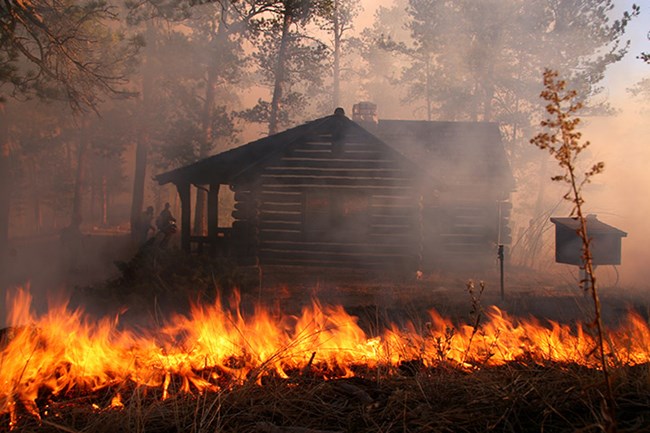
NPS Photo Fire as a Natural ProcessFor thousands of years, wildfire has shaped the landscape of the Northern Great Plains. In the Jewel Cave area, most natural fires are ignited by lightning. When conditions align with high temperatures, steady winds, and low humidity, these fires can ignite easily and spread rapidly. Indigenous Fire StewardshipLong before modern land management practices, Indigenous communities such as the Oglala Lakota used fire intentionally. Controlled burns were used to protect camps from large wildfires, to influence bison movement toward hunting grounds, and to promote the growth of useful plant species, including those used for medicine and food. This traditional ecological knowledge highlights fire as a tool rather than a threat. When applied thoughtfully, fire supports healthy landscapes and cultural practices.The Cost of SuppressionThroughout the 20th century, fire suppression policies were widely adopted to protect people, property, and infrastructure. While effective in the short term, this approach disrupted natural fire cycles. Small, low-intensity fires that once cleared excess vegetation were prevented, resulting in the buildup of dry grasses, pine needles, and dead trees. Today, wildfires often burn more intensely and are more difficult to contain due to the accumulation of these fuels.
NPS Photo The Role of Prescribed FireModern fire management recognizes the importance of restoring fire to the landscape in a safe and planned way. Prescribed fires are carefully designed to reduce hazardous fuel buildup, maintain healthy ecosystems, and protect nearby communities. These burns are conducted under specific weather conditions and take into account vegetation type, moisture levels, and management goals.At Jewel Cave, prescribed fire has had a measurable impact. In 1999, the Lithograph Canyon Fire was used to reduce fuels near the visitor center. Less than a year later, the Jasper Fire moved through the same area. Because fuels had already been reduced, the fire burned less intensely near park infrastructure and likely helped save those buildings. The Jasper FireOn August 24, 2000, the Jasper Fire began just west of Jewel Cave and quickly became the largest wildfire in the recorded history of the Black Hills. It burned 83,508 acres, including approximately 90 percent of the monument. Hot, dry weather and years of fuel buildup contributed to the fire’s rapid growth. On its first day, the fire burned the equivalent of seven football fields per minute.As the fire approached, park staff evacuated the area. Important records and equipment were moved into the cave for protection. Wildland firefighters worked to defend the park’s structures. All buildings were saved, including the historic entrance cabin, which was coated multiple times with fire-retardant foam. 
NPS Photo Recovery and ResilienceToday, the landscape continues to recover. Visitors can still see evidence of the Jasper Fire along trails such as the Roof Trail and the Canyons Trail. Charred tree trunks and standing snags serve as reminders of the fire’s intensity. However, the forest is regrowing. Grasses, wildflowers, and young pine trees are becoming more widespread. Wildlife has returned to the area, taking advantage of the open space and renewed vegetation.Fire Awareness and Your RoleFire can be a powerful ally in maintaining a healthy forest. When used intentionally and responsibly, it helps clear overgrown vegetation, returns nutrients to the soil, and supports plant and animal diversity. Whether through Indigenous fire practices or modern prescribed burns, the use of fire has long been a part of successful land management.As a visitor to Jewel Cave, you play an important role in wildfire prevention. Staying informed, respecting fire restrictions, and practicing safe behaviors while on public lands all contribute to a safer and healthier environment. |
Last updated: June 22, 2025
